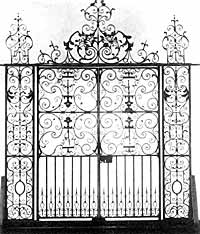The following is a list of the early Rectors, as given in Torre’s MS.:—
| 11 March 1282 | Hen. de Newton. Will de Colewyks. mil. |
| 2 March 1322. | Rog. fil Ric. de Belegant de Stainton. Idem. |
| 28 August 1326 | Joh. de Stanton de Lancaster. Idem. Joh. de Caton (died) |
| 3 April 1348. | Phil de Colwyk. Tho. de Longvillers, mil. |
| 15 April 1358. | Will. Marescall de Stretford. Will, de Colwyk (resd. for the Vicarage of Getyn, Linc, dioc.) |
| 8 March 1363. | Will Freman. Ric. de Bevercotes (resigned for the Church of Boudon, Linc, dioc.) |
| 12 Dec. 1365. | Will Sewalle. Idem, (resigned) |
| 10 Dec. 1368. | Joh. Godwyn. Idem, (resigned) |
| 30 Aug. 1409. | Robt Poule. Dame Joana relict of Ric. Byron, mil. (resigned for the Church of Stilton, Linc. dioc.) |
| 23 Aug. 1413. | Joh. fil. de Will. Maggeson de Estwell. Eadem (resigned for the Vicarage of Wyrkesworth, Carlisle Diocese.) |
| 10 July 1420. | Will. Henryson. Peter de la Pole. |
| 10 Oct. 1437 | Thurstan Percivall. Feoffees of Jonn Byron, mil. Ric. Pendilton (died) |
| 12 Feb. 1487. | Joh. Holme. Joh. Byron mil. (died) |
| 28 April 1496. | Will Preston. Dame Alicia Byron. |
| 1509. | Will. Alrede. Joh. Byron arm. (died). |
| 30 Jan. 1519. | Will. Martyne. Dame Joanna Clyfton, widow of Joh. Byron arm. |
| Olyver Haywoode (deprived). | |
| 17 June. 1569. | Joh. Cletam. Joh. Byron arm. (died) |
| Nov 1569.1 | Will Aldridge. Idem (died) |
| 15 March 1627 | Robt. Theobalds. Joh. Byron de Bal. mil |
| 26 March 1662. | Carolus Parrey. Joh. Musters arm. |
The Registers of Colwick2 date from 1569, when John Cletam was rector. He was followed by William Aldred, who was rector for fifty-one years (1576—1627). His successor was Robert Theobald, a scholar of some distinction, and the author of Latin verses, who was elected Scholar of Trinity College, Cambridge, from Westminster School, in 1601; and appointed Headmaster of Nottingham Free Grammar School, on 29th May, 1616. He was to have “20li wages and the howse and to be moderate in takinge borders.” During his mastership, the celebrated Colonel Hutchinson was a boy in the school. Writing in the Memoirs, concerning her sons, Mrs. Hutchinson says, “when it was time for them to go to school, both the brothers were sent to board with Mr. Theobald, the master of the Free School at Nottingham, who was an excellent scholar; but having no children, some wealth, and a little living that kept his house, he first grew lazy, and after, left off his School.” He resigned the mastership in 1627, and then became Rector of Colwick. He appears to have lived with the Hutchinsons in Nottingham while he was rector, for the Memoirs say “there was also an old man who had been Mr. Hutchinson’s first schoolmaster, a person once of great learning, but afterwards becoming a cynic, yet so pleasantly maintaining that kind of humour, that his conversation was sometimes a good diversion.” His remarkably clear handwriting is in the registers from 1628-1643, the year of his death. The entry of his burial, which is very faint and almost illegible, is as follows:—“Mr. Robert Theobald Master of Arts and Rector of Colwick was buried the 23rd of June 1643.”

Wrought iron gates from Colwick Hall (now in Castle Museum).
The churchyard is separated from the grounds on the south by a high wall, which corresponds with the brickwork of the hall. The enclosing wall on the north and west sides, the entrance gates, and one of the gate piers, were set up when the churchyard was enlarged about twenty-five years ago. The ancient appearance of this work is due to the fact that none but old materials were used in construction. The bricks were collected from other parts of the estate, and the wrought iron gates were found lying derelict, in the churchyard. A similar, but much more elaborate pair of gates had been brought to light five years previously, while the vestry on the north side of the church was in course of erection. The discovery was made in this wise. In order to make the new work harmonize with the old, a search was made for any old stone which might be suitable for the purpose. The cap of a gate pier was seen protruding from the mud in the “trench” near the old private entrance on the river bank at the west side of the park. The process of hauling this out revealed not only the stone piers, but also a pair of wrought iron gates. These very fine gates are contemporary with the hall (1776). It therefore, seems highly probable that they were torn down and thrown into the water by the rioters when they entered the grounds at this point in 1831. The leaf and scroll-work is identical with examples of contemporary ironwork in the district,3 which leads me to think they were made locally, although nothing is actually known concerning the craftsman. The stone piers were cut up and used in the building; the gates are now on view in the Castle museum at Nottingham.
The route by the river proved so attractive that the party returned by steamer, and reached Nottingham between five and six o’clock.
(1) Parish register gives 1576.
(2) Contributed by Mr. S. Corner.
(3) Wrought iron screen at All Saints’ Church, Derby, made by Bakewell of
Derby, 1723. Ironwork at the old silk mill at Derby. Gates to Belton House,
Grantham, 1718-1754. See also illustrations in “Transactions Vol. XVI.
